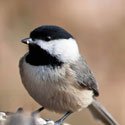Bird Feeders
 Some bird, mainly sparrows, prefer to feed on the ground. However, most birds enjoy eating at an elevated feeder. Feeders also provide a safer place for birds to eat at a safe distance from predators, such as cats. Different birds are attracted to different types of feeders. The information below will help you choose the best type of feeder for your yard and the type of birds you want to attract.
Some bird, mainly sparrows, prefer to feed on the ground. However, most birds enjoy eating at an elevated feeder. Feeders also provide a safer place for birds to eat at a safe distance from predators, such as cats. Different birds are attracted to different types of feeders. The information below will help you choose the best type of feeder for your yard and the type of birds you want to attract.
Feeder Types
Platform Feeders: These are simple, platforms with raised sides to hold in the bird food. Some have mesh bottoms, or some other form of drainage, so the food doesn't get soggy. A canopy over the platform will also help to keep the food dry. Platforms are good choices for feeding larger birds and for attracting flocks.
Hopper Feeders: This common form of feeder can be used for just about any type of seed. Hopper feeders can be hung or mounted on a pole. Some models have an even flow seed distributor that rations the seeds. The roof keeps seed drier than a platform feeder does. The best choice for attracting the largest variety of birds, but competition at this type of feeder may discourage smaller birds.

Tube Feeders: Tube feeders can be either hung or pole mounted. Some have a tray to catch spilled seeds. Tube feeders are best for feeding small birds that can easily perch at the feeding holes. Some tube feeders are specifically designed to dispense thistle seed for finches. This is the best type of feeder for attracting goldfinches. Fill a tube feeder with thistle seed and you're likely to see these beautiful bright yellow birds in your yard.
Suet Feeders: Most suet feeders are mesh or wire cages that hold suet cakes and balls. Suet can also be hung in simple mesh bags, but these don't hold up well to squirrels and raccoons. Suet feeders are particularly good in the spring and winter, when birds need the high energy food that suet provides. The type of birds attracted to a suet feeder depends somewhat on the "flavor" of suet you provide. You can find suet mixes that contain seed, fruit and even insects to attract specific birds.
Tips for Bird Feeder Selection
Look for feeders with drainage holes in the bottoms of the feeder hopper and the seed try. This allows rainwater to drain and helps keep seed from spoiling.
Look for feeders with shallow plate-like seed trays that will catch seed and allow empty seed shells to blow away. Deep accumulations of seed and bird droppings can create a situation that is unhealthy for your visiting birds.
Choose tube feeders with metal ports to keep squirrels from chewing open the holes.
Ceramic and metal feeders are less apt to be destroyed by squirrels.
Seed trays allow larger birds to use tube feeders. If you want to discourage larger birds, use a feeder without a tray.

